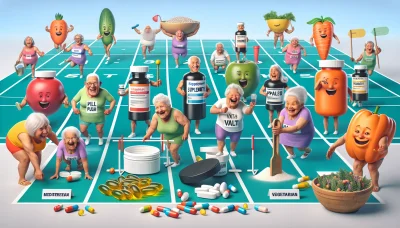Heart healthy market Quiz
Test Your Knowledge
Question of
Understanding Heart-Healthy Diets
Basics of a Heart-Healthy Diet
A heart-healthy diet is fundamental in preventing cardiovascular diseases and maintaining optimal heart health. It focuses on consuming foods rich in nutrients, fiber, and healthy fats while limiting processed foods, sugars, and unhealthy fats. This approach not only supports the heart but also contributes to overall well-being.
Adopting a heart-healthy diet involves making informed choices about what you eat every day. It's about creating a balanced plate that supports your heart's function and reduces the risk of heart disease. By focusing on variety and nutrient-dense foods, individuals can enjoy delicious meals that are both satisfying and beneficial for heart health.
Key Nutrients for Heart Health
Fiber, omega-3 fatty acids, antioxidants, and potassium are powerhouse nutrients for your heart. Foods rich in these nutrients help reduce blood pressure, lower cholesterol levels, and decrease the risk of heart disease. Incorporating a variety of these nutrient-dense foods into your diet is a surefire way to support your heart health.
Omega-3 fatty acids, found in fatty fish like salmon and flaxseeds, are critical for heart health. They help reduce inflammation and lower the risk of heart rhythm disorders. Antioxidants protect your cells from damage, while potassium helps manage blood pressure levels. A diet rich in these nutrients is your heart's best friend.
Foods to Include and Avoid
To support a healthy heart, focus on including fruits, vegetables, whole grains, lean protein sources like fish and poultry, nuts, seeds, and legumes in your diet. These foods provide essential nutrients that promote heart health. On the other hand, it's crucial to limit or avoid red meat, processed foods high in sodium or sugar, refined grains, and trans fats as they can contribute to heart disease.
Making smart food choices is key to a heart-healthy diet. Prioritize fresh over processed foods and opt for cooking methods like grilling or baking instead of frying. Remember: what you choose to eat has a direct impact on your heart health!
Popular Heart-Healthy Diet Plans
The DASH Diet Explained
The Dietary Approaches to Stop Hypertension (DASH) diet is a scientifically proven method to lower blood pressure without medication through dietary changes. It emphasizes fruits, vegetables, whole grains, lean proteins, and low-fat dairy while reducing sodium intake. This plan not only lowers blood pressure but also aids in weight loss and improves overall health.
The DASH diet is flexible and easy to follow. It focuses on portion sizes, eating a variety of foods, and getting the right amounts of nutrients. By following the DASH diet guidelines, individuals can significantly improve their heart health and reduce their risk of developing cardiovascular diseases.
The Mediterranean Diet Benefits
The Mediterranean diet is renowned for its numerous health benefits, particularly when it comes to protecting the heart. It centers around plant-based foods like fruits, vegetables, whole grains, olive oil as the primary fat source; moderate consumption of fish and poultry; and minimal intake of red meat and dairy products.
- Eat Plenty of Fruits and Vegetables: They're packed with vitamins, minerals, fiber, and antioxidants which are essential for good health.
- Use Olive Oil as Your Main Fat Source: Rich in monounsaturated fats that can help reduce bad cholesterol levels.
- Incorporate Fish into Your Meals Regularly: Fish such as salmon are high in omega-3 fatty acids that benefit the heart by lowering triglycerides.
- Limited Red Meat Consumption: Opt for leaner cuts when you do eat red meat and keep portions small to minimize saturated fat intake.
- Moderate Dairy Intake: Choose low-fat or fat-free dairy options to enjoy their benefits without excessive saturated fat.
The Mediterranean diet not only supports cardiovascular health but also promotes longevity and reduces the risk of chronic diseases. Its emphasis on whole foods over processed ones makes it an enjoyable way to eat healthily while still savoring delicious meals.
The Impact of Diet on Heart Health
Scientific Research on Diet and Cardiovascular Disease
Extensive scientific research has established a robust link between diet and the risk of cardiovascular disease. Studies have shown that diets high in saturated fats, trans fats, and cholesterol can lead to heart disease. Conversely, diets rich in fruits, vegetables, whole grains, and lean proteins can protect the heart.
Researchers are constantly uncovering new insights into how specific nutrients affect heart health. For example, omega-3 fatty acids found in fish have been shown to reduce the risk of arrhythmias and decrease triglyceride levels.
Recent Studies on Heart Health and Nutrition
Recent studies have further emphasized the importance of dietary patterns over individual nutrients in promoting heart health. The Mediterranean diet, characterized by its high consumption of olive oil, nuts, fruits, and vegetables, has been linked to a significant reduction in heart disease risk.
Another promising area of research focuses on the role of dietary fiber. High fiber intake has been associated with lower rates of heart disease and stroke. This highlights the need for a diet rich in whole grains, fruits, and vegetables.
Long-Term Effects of Dietary Choices on the Heart
The long-term impact of dietary choices on heart health cannot be overstated. Consistently poor dietary habits can lead to the development of chronic conditions such as hypertension, diabetes, and obesity, which are major risk factors for cardiovascular disease.
Maintaining a heart-healthy diet throughout life is crucial for preventing heart disease. It's not just about avoiding unhealthy foods but actively incorporating nutritious options that support overall cardiovascular health.
Managing Cholesterol Through Diet
One of the most direct ways to influence heart health through diet is by managing cholesterol levels. High levels of LDL ("bad") cholesterol are a well-known risk factor for heart disease. Dietary choices play a key role in both lowering LDL cholesterol and increasing HDL ("good") cholesterol.
Foods That Help Lower Cholesterol
Eating a diet rich in fruits, vegetables, whole grains, lean protein, and healthy fats can help lower cholesterol levels. Foods particularly effective at lowering cholesterol include oats, barley, nuts, fatty fish like salmon and mackerel, and fiber-rich fruits like apples and pears.
- Oats and Barley: Rich in beta-glucan, a type of soluble fiber that helps reduce LDL cholesterol.
- Nuts: Almonds, walnuts, and other nuts can significantly reduce cholesterol when eaten regularly.
- Fatty Fish: Omega-3 fatty acids in fish help lower triglycerides and increase HDL cholesterol levels.
- Fruits: Fruits high in soluble fiber like apples and pears contribute to lower LDL levels.
- Soy: Soy products have been shown to modestly reduce LDL cholesterol levels.
Understanding Good vs. Bad Cholesterol
"Good" cholesterol (HDL) helps remove other forms of cholesterol from your bloodstream. Higher levels of HDL are associated with lower risk of heart disease. "Bad" cholesterol (LDL), on the other hand, can build up inside artery walls leading to blockages and increasing the risk for heart attacks.
A healthy diet plays a pivotal role in managing these cholesterol levels. By choosing foods that promote higher HDL levels while reducing intake of those that raise LDL levels, individuals can significantly impact their cardiovascular health positively.
Diet and Blood Pressure Control
Natural Ways to Reduce Hypertension
Reducing hypertension naturally is not only possible, but it's also incredibly empowering. By focusing on what we eat, we can significantly influence our blood pressure levels. This approach not only helps in managing hypertension but also enhances overall well-being.
Key dietary adjustments can lead to substantial improvements in blood pressure control. It's about making smarter food choicesopting for whole grains, fruits, vegetables, and lean proteins. These changes can dramatically lower blood pressure and reduce the risk of heart disease.
Dietary Changes for Blood Pressure Management
Integrating specific foods into your diet is a game-changer for controlling high blood pressure. Foods rich in magnesium, calcium, and fiber have been shown to be particularly effective. Think leafy greens, oats, and berriesnature's prescription for a healthy heart.
It's not just about what you add to your diet but also what you limit. Reducing intake of processed foods, which are often high in sodium and unhealthy fats, is crucial. This simple change can make a world of difference to your blood pressure readings.
The Role of Sodium and Potassium Balance
The balance between sodium and potassium in your diet is critical for blood pressure management. Excessive sodium can lead to water retention, elevating blood pressure. Conversely, potassium helps counteract sodium's effects by relaxing the blood vessel walls.
- Avoid Hidden Sodium: Be wary of processed foods and condiments that are often loaded with salt.
- Increase Potassium Intake: Consume potassium-rich foods like bananas, sweet potatoes, and spinach to help mitigate sodium's impact on your body.
- Read Labels Carefully: Always check nutrition labels for sodium content to make informed choices.
- Cook at Home: Preparing meals at home allows you to control the amount of salt used.
The Importance of Weight Management
Maintaining a healthy weight is not just about looking goodit's a vital component of managing high blood pressure. Excess weight forces your heart to work harder to pump blood throughout your body, which can raise your blood pressure.
Losing even a small amount of weight if you're overweight or obese can help reduce your blood pressure significantly. It's one of the most effective natural interventions available, with benefits extending far beyond just blood pressure control.
How Obesity Affects Blood Pressure
The link between obesity and high blood pressure is undeniable. Fat tissue requires oxygen and nutrients, necessitating increased blood flow that puts additional strain on the arteries. This can lead to higher than normal blood pressure levels.
Beyond just the numbers on the scale, where body fat is distributed can also impact blood pressure. Visceral fatthe fat surrounding abdominal organsis particularly problematic as it has been linked with various health issues including hypertension.
Strategies for Achieving a Healthy Weight
Achieving a healthy weight involves adopting a holistic approach that includes diet modification, regular physical activity, and behavioral changes. Its about creating a sustainable lifestyle that promotes overall health and well-being.
Focusing on nutrient-dense foods while limiting calories from sugars and fats is crucial. Additionally, incorporating regular exercise into your routine not only aids weight loss but also strengthens your heart and lowers stress levelsboth beneficial for reducing blood pressure.
Anti-Inflammatory Foods for a Healthy Heart
Identifying Anti-Inflammatory Foods
Inflammation is a root cause of many chronic diseases, including heart disease. Identifying and consuming anti-inflammatory foods can play a pivotal role in maintaining heart health. These foods work by reducing inflammation markers in the body, thus protecting the heart.
Benefits of Omega-3 Fatty Acids: Omega-3 fatty acids are powerhouse nutrients found in fish like salmon and mackerel. They significantly reduce the body's production of inflammatory eicosanoids and cytokines. Regular intake of omega-3s is linked to reduced risk of heart diseases, thanks to their inflammation-lowering powers.
Role of Antioxidants in Inflammation Reduction: Antioxidants such as vitamins C and E, found in fruits and vegetables, neutralize free radicals that can cause oxidative stress and inflammation. Foods rich in antioxidants can thus help lower the risk of heart disease by combating inflammation.
Incorporating Anti-Inflammatory Foods into Your Diet
Integrating anti-inflammatory foods into your diet isn't just beneficial; it's necessary for heart health. This process involves mindful meal planning and choosing recipes that include these powerful ingredients. The goal is to make these foods a regular part of your eating habits.
Meal Planning for Inflammation Control: Meal planning is a strategic approach to incorporate anti-inflammatory foods into every meal. It involves selecting a variety of foods rich in omega-3s, antioxidants, and other anti-inflammatory agents. This ensures a balanced intake of nutrients essential for reducing inflammation.
- Eat a rainbow: Incorporate fruits and vegetables of different colors to get a wide range of antioxidants.
- Choose whole grains: Opt for whole grains over refined ones to maximize fiber intake, which can help reduce inflammation.
- Favor healthy fats: Include sources of healthy fats like avocados, nuts, and olive oil in your diet.
- Leverage spices: Many spices, such as turmeric and ginger, have potent anti-inflammatory properties.
- Limited processed foods: Processed foods can contribute to inflammation; therefore, minimizing their consumption is crucial.
Easy-to-Prepare Anti-Inflammatory Recipes: Preparing meals that fight inflammation doesn't have to be time-consuming or complicated. There are numerous simple recipes that incorporate anti-inflammatory ingredients. These meals not only support heart health but are also delicious and satisfying.
The Role of Fiber in Heart Health
Types of Fiber and Their Benefits
Fiber is a superhero in the world of nutrition, playing a crucial role in maintaining heart health. It comes in two main types: soluble and insoluble, each with its unique benefits. Soluble fiber dissolves in water to form a gel-like substance, aiding in cholesterol management, while insoluble fiber helps with digestive health by adding bulk to the stool.
Increasing your fiber intake is a game-changer for heart health. Research consistently shows that diets high in fiber are linked to a lower risk of heart disease. This is because fiber-rich foods not only improve cholesterol levels but also help control blood sugar levels and maintain a healthy weight.
Soluble vs. Insoluble Fiber: What's the Difference?
Soluble fiber is your heart's best friend. It can lower bad cholesterol levels by binding with cholesterol particles in your digestive system and removing them from the body. Foods rich in soluble fiber include oats, beans, lentils, apples, and blueberries.
On the other hand, insoluble fiber is the unsung hero of regular bowel movements and preventing constipation. It's found in whole grains, nuts, seeds, carrots, and cucumbers. While it doesn't directly impact heart health like soluble fiber does, it's essential for overall digestive wellness.
High-Fiber Foods to Add to Your Diet
- Oats: A powerhouse of soluble fiber; perfect for breakfast.
- Beans: Versatile and rich in both types of fiber; great in salads or soups.
- Berries: Packed with antioxidants and fibers; an ideal snack or dessert topping.
- Nuts and Seeds: A healthy crunch full of insoluble fiber; excellent as a snack or salad garnish.
- Vegetables: Carrots and broccoli are high in fibers; add them generously to your meals.
Fiber's Effect on Cholesterol and Digestion
Fiber plays a pivotal role in managing cholesterol levels, which directly impacts heart health. Soluble fiber specifically has the ability to bind with cholesterol in the digestive system and help remove it from the body. This process not only lowers bad cholesterol levels but also helps reduce the risk of developing heart disease.
Beyond cholesterol management, fiber is essential for optimal digestive health. It helps regulate bowel movements and can prevent common issues such as constipation. But that's not all there's an undeniable connection between gut health and heart health. A healthy gut contributes to a strong heart by reducing inflammation and controlling blood pressure.
How Fiber Lowers Cholesterol Levels
Eating foods high in soluble fiber is key to lowering bad LDL cholesterol levels. This type of fiber binds with bile acids needed for the digestion of fat, leading the body to use up cholesterol to replace them. This process effectively lowers the overall cholesterol levels in the body, contributing significantly to heart health.
The Connection Between Gut Health and Heart Health
The gut is often called the second brain for good reason its health impacts our overall well-being including our hearts. A diet rich in fibers promotes a healthy gut microbiome which plays a crucial role in reducing inflammationa major risk factor for heart disease. Moreover, a balanced gut flora helps regulate blood pressure by metabolizing certain nutrients more efficiently, making fibers an all-round champion for heart health.
Heart-Healthy Eating Habits
Portion Control and Meal Timing
Understanding Serving Sizes for Heart Health
Mastering the art of portion control is essential for maintaining a heart-healthy diet. It's not just about what you eat, but how much you eat. Oversized portions can lead to weight gain, increasing the risk of heart disease. Familiarize yourself with serving sizes recommended by nutrition experts, often much smaller than what's typically served at restaurants or at home. This knowledge empowers you to make healthier choices every day.
To keep your heart ticking strong, focus on filling half your plate with vegetables and fruits, a quarter with lean proteins, and the remaining quarter with whole grains. This balance ensures you're getting a wide range of nutrients without overloading on calories or unhealthy fats. Remember, managing serving sizes is a powerful tool in your heart-health arsenal.
The Best Times to Eat for Optimal Heart Health
Eating your meals at consistent times each day can significantly benefit your heart health. An irregular eating schedule can disrupt your body's internal clock, leading to poor cholesterol levels and higher body weight. Aim to eat meals at similar times daily to keep your metabolism steady and your heart health in check.
Breakfast kickstarts your metabolism and should not be skipped; it sets the tone for a day of heart-healthy eating. Following that, spacing meals four to six hours apart stabilizes blood sugar levels, preventing sudden spikes or drops that can be harmful over time. Prioritizing a lighter meal in the evening can also contribute to better heart health by giving your body ample time to digest before sleep.
Mindful Eating and Heart Health
The Principles of Mindful Eating
Mindful eating revolves around being fully present during meals, paying close attention to the flavors, textures, and sensations of what you're eating. This practice encourages you to slow down and listen to your body's hunger cues, promoting satisfaction with smaller portions. Embracing mindful eating can lead to significant improvements in dietary choices and overall heart health.
By focusing on the experience of eating, mindful eaters are more likely to choose nutritious foods that support heart health. They're also less prone to emotional eating and more equipped to recognize when they're full, reducing the likelihood of overeating and its associated risks.
How Mindfulness Can Prevent Overeating
Mindfulness is a powerful tool against overeating. It helps individuals distinguish between true hunger and emotional cravings, reducing instances of mindless snacking or binge eating. When you eat mindfully, you're more aware of your food choices and portion sizes, directly impacting your heart health positively.
- Avoid distractions: Eat away from TVs, computers, and phones to fully focus on your meal.
- Eat slowly: Take time to chew thoroughly and enjoy each bite; this gives your body time to recognize fullness.
- Listen to hunger cues: Learn to differentiate between actual hunger and boredom or stress-related cravings.
- Savor every bite: Appreciate the flavors and textures of your food; this can help satisfy cravings with smaller portions.
Incorporating these habits into your daily routine can transform the way you view food and its impact on heart health. By adopting mindful eating practices and being vigilant about portion control and meal timing, you're taking significant steps toward a healthier heart actions that pay off now and in the long term! Remember: **Your heart is counting on you**!
Planning Heart-Healthy Meals
Creating a Balanced Meal Plan
A balanced meal plan is crucial for heart health, focusing on macronutrients that support cardiovascular function. It's not just about what you eat, but how these elements work together to fuel and protect your body. Understanding the right balance of carbohydrates, proteins, and fats can make a significant difference in your heart's wellbeing.
When it comes to macronutrients, emphasizing whole grains, lean proteins, and healthy fats is key. These components help manage cholesterol levels, reduce blood pressure, and decrease the risk of heart disease. Incorporating a variety of these foods into your diet ensures nutrient diversity for optimal heart health.
A Guide to Macronutrient Ratios for Heart Health
For heart health, aim for a macronutrient ratio that prioritizes vegetables, fruits, whole grains, and lean proteins. A general guideline is to fill half your plate with fruits and vegetables, a quarter with whole grains, and the remaining quarter with lean protein sources. This balance supports cardiovascular health by providing essential nutrients and fiber while managing caloric intake.
Weekly Meal Planning Tips for Busy Individuals
Meal planning can be a life-saver for busy individuals looking to maintain a heart-healthy diet. By allocating time each week to plan meals, you can ensure that you're eating a balanced diet rich in nutrient-dense foods. This not only saves time but also reduces the temptation to opt for less healthy convenience foods.
- Plan Your Meals Around Whole Foods: Start with vegetables, fruits, whole grains, and lean protein sources as the base of your meals.
- Prepare Ingredients in Advance: Wash and chop vegetables or cook grains ahead of time to streamline meal preparation during the week.
- Batch Cook: Prepare larger quantities of meals that can be refrigerated or frozen for later use. This approach saves both time and energy.
- Keep Healthy Snacks on Hand: Stock up on healthy snack options like nuts, seeds, fresh fruit, and yogurt to curb hunger between meals without compromising heart health.
Cooking Techniques and Heart Health
The way you cook your food can significantly impact its nutritional value and its effects on heart health. Opting for cooking methods that preserve nutrients while minimizing unhealthy fats is crucial. Techniques such as steaming, grilling, baking, and sauting can make meals healthier without sacrificing flavor.
Healthy Cooking Methods to Preserve Nutrients
Steaming is one of the best ways to cook vegetables as it preserves most vitamins and minerals. Grilling lean meats and vegetables adds flavor without extra fat. Baking or roasting with minimal oil allows for caramelization and depth of flavor while keeping dishes nutritious and heart-friendly.
Flavorful Herbs and Spices That Benefit the Heart
Incorporating herbs and spices into meals not only enhances flavor without adding sodium but can also offer cardiovascular benefits. For example, garlic has been shown to lower blood pressure while cinnamon may improve cholesterol levels. Experimenting with various herbs and spices adds excitement to meals while contributing to a healthier heart.
Overcoming Challenges to Maintaining a Heart-Healthy Diet
Dealing with Cravings and Dietary Slip-Ups
Strategies to Handle Unhealthy Food Cravings
Cravings for unhealthy foods can derail even the most committed heart-healthy dieter. Identifying triggers, such as emotional states or specific environments, is crucial. Once identified, you can create strategies to avoid or cope with these triggers. Replacing unhealthy cravings with healthier alternatives that still satisfy your taste buds can make a significant difference. Remember, it's about balance, not deprivation.
Mindful eating practices are key to managing cravings effectively. By paying attention to hunger cues and savoring each bite, you're more likely to recognize when you're full and avoid overindulging. Planning meals ahead also helps prevent impulsive decisions that might lead you astray from your heart-healthy goals. Stay hydrated; sometimes thirst is mistaken for hunger, leading to unnecessary snacking.
Getting Back on Track After a Setback
Setbacks are a natural part of any journey toward a healthier lifestyle. The key is not to let them define your path. Acknowledge the setback without harsh self-judgment and understand what led to it. This understanding can help you develop strategies to prevent similar situations in the future. Remember, every day is a new opportunity to make heart-healthy choices.
Redefining your relationship with food is essential for long-term success. Food should be viewed as fuel for your body rather than an emotional crutch. When you slip up, refocus on your goals and the reasons behind themyour heart health is worth it! Consistency over time leads to results; don't let temporary setbacks discourage you from your ultimate objective.
Staying Motivated for Long-Term Heart Health
Setting Realistic Goals and Celebrating Milestones
Setting realistic goals is foundational to maintaining motivation. Start with small, achievable targets that lead toward your larger objective of heart health. Each small victory builds confidence and reinforces your commitment. Celebrating milestones, no matter how minor they may seem, boosts motivation and keeps the journey rewarding.
It's important not just to set goals but also to review and adjust them regularly. Life changes and so will your capabilities and circumstances; your goals should reflect this dynamic nature. Always aim for progress, not perfection, allowing yourself grace along the way.
Building a Support System for Dietary Success
A strong support system can significantly enhance your ability to stick with a heart-healthy diet. Surround yourself with friends and family who understand and support your dietary goals. Joining groups or communities of like-minded individuals provides not only encouragement but also valuable tips and recipes that can make adhering to a heart-healthy diet more enjoyable.
Dont underestimate the power of accountability partners in keeping you honest and motivated. Sharing goals, successes, and even setbacks with someone else makes the journey less daunting and more achievable. Together, you can celebrate each others victories and provide support during challenging times.












